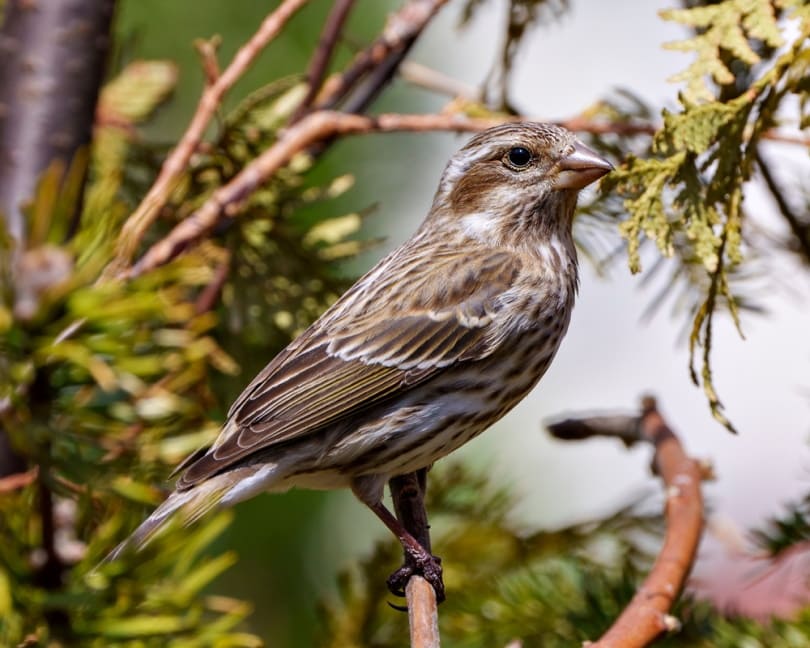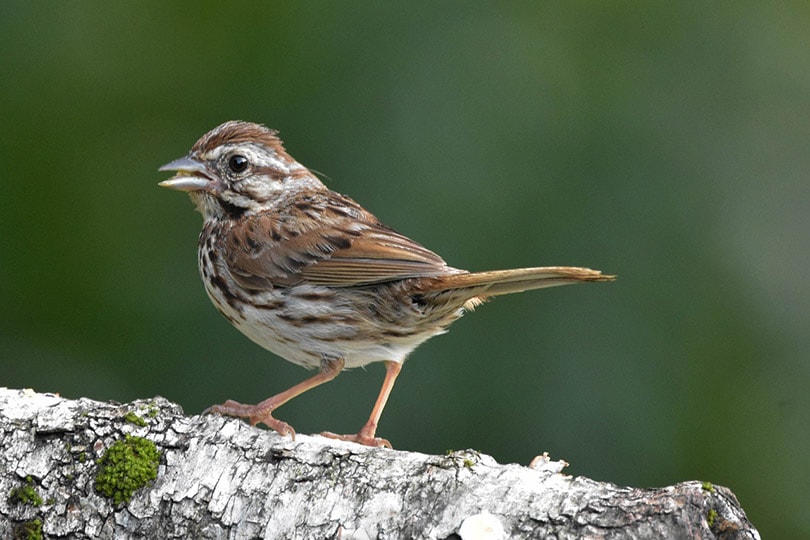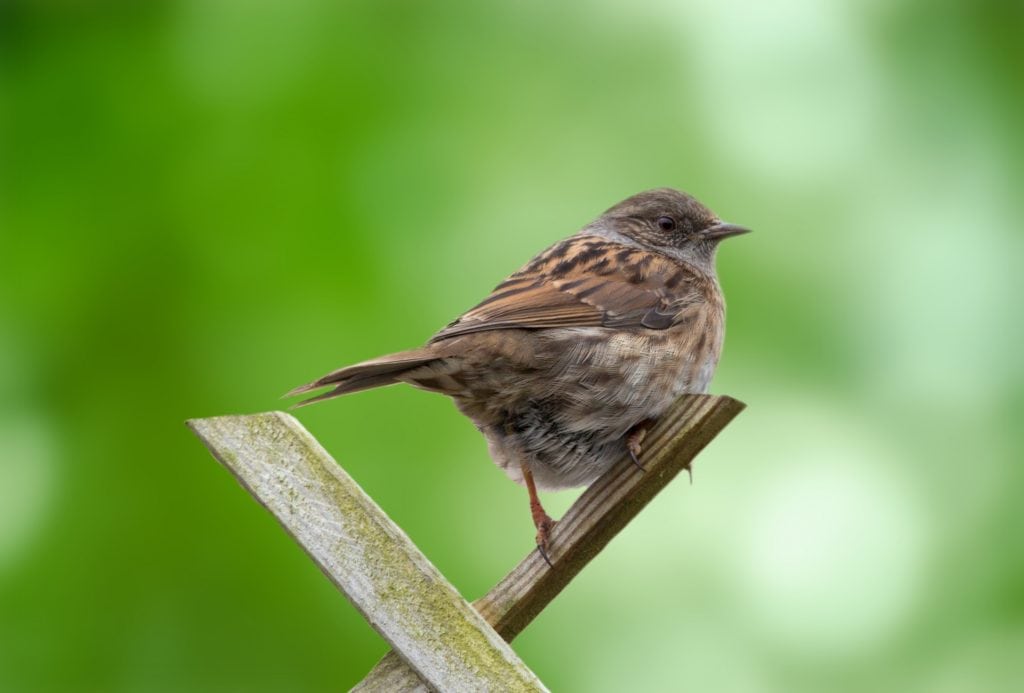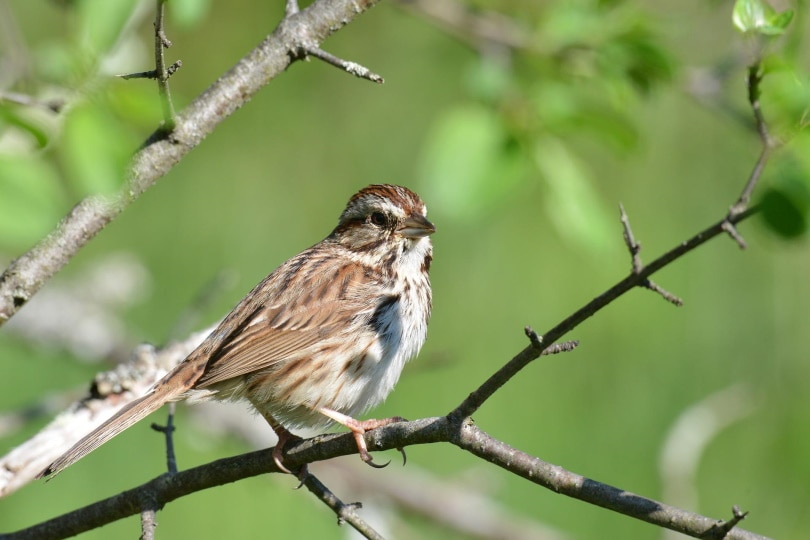Song Sparrow: Field Guide, Pictures, Habitat & Info
Last Updated on

Song Sparrows are among the most abundant native bird breeds1 in the United States and Canada. These birds don’t migrate in some parts but may migrate from the northern area to the Southern United States or Mexico in winter.
Song Sparrows are ground foragers, primarily found in overgrown fields, forest edges, and backyards. Both males and females sing well, particularly to invite the other gender to mate.
You can identify Song Sparrows by their russet and gray bodies with bold streaks down their white chests. So, let’s explore more about these adorable birds’ range, habitat, and behavior.

Quick Facts About the Song Sparrow
| Habitat | Open woodlands, backyards, marsh edges, overgrown fields, forest edges, desert washes, and willow thickets |
| Diet | Insects, seeds, fruits, and small insects |
| Behavior | Ground foragers |
| Nesting | Sheltered locations, trees, or shrubs |
| Conservation | Least concern, the population is stable |
| Scientific name | Melospiza melodia |
| Lifespan | 11 years |
Song Sparrow: General Description
Song Sparrows are widely-familiar birds in North America. The adult birds have a subtle brown upper body with dark or bold streaks on the back. These birds are white from the chest with dark streaks and have a brownish spot in their breast’s middle part.
Whenever you see a streaky brown sparrow with a brown cap and a long, rounded tail flying out in the open, know that you’ve witnessed Song Sparrow.
These birds sing pretty well, and the song remains similar throughout North America.

Song Sparrow: Range, Habitat, Behavior, Diet & Nesting
Song sparrows are seen in abundance throughout the year. Here is what you need to know more about this bird breed:
Range
Song Sparrows’ range stays continuous, starting from the Aleutians to the eastern part of the United States. Some bird populations also live on Central Mexico’s plateau, which is approximately 900 miles away from the closest population. Song Sparrows can be migratory and non-migratory.
Habitat
Song Sparrows are found in flocks in various open habitats. These could be arctic grasslands, pine forests, tidal marshes, desert scrub, aspen parklands, pacific rain forests, overgrown pastures, forest edges, suburbs, freshwater marsh, and pond edges. You can also find Song Sparrows in mixed or deciduous woodlands.
Behavior
Song Sparrows like to stay on the ground and forage without other species around. However, males may fly, feed, and sing in exposed perches, such as small tree limbs. These birds are often seen hopping on the ground from one branch to another.
Courting Song Sparrows fly in flocks, fluttering their brown wings with dangling legs. Generally, all Song Sparrows are monogamous, but a few young ones live with multiple mates in every breeding season.
Juvenile birds gather in loose flocks around trees and water sources. They have rounded wings, so their flight is direct and low. They mostly take only short flights, from one perch to another.

Diet
These birds are carnivorous and herbivorous. They eat different types of insects and small invertebrates in the summer season and seeds and fruits throughout the year. These insects include caterpillars, grasshoppers, leaf beetles, midges, spiders, craneflies, dragonflies, ground beetles, etc.
Plant-based foods include clover, sunflower, wheat, strawberries, blueberries, rice, wild cherries, mulberries, and raspberries. Song Sparrows may also have other meals in their diet, depending on the foods available across their range.
Nesting
The male and female Song Sparrows hunt for the perfect nest location together. Their nesting places are hidden in forest edges, grasses, or weeds. The other times, they are seen building their nests on the ground and sometimes 15 feet above or near water.
These birds are not at all afraid of humans. So, they can easily nest close to residential homes, primarily in flower beds.
The female Song Sparrow creates the nest in the morning. The typical nest of a Song Sparrow is made of loose grass and tree bark on the outside. They are lined more tidily with animal hair and grasses. It typically takes around 4–5 days for these birds to construct a nest.
How to Find Song Sparrows: Birdwatching Tips
Finding Song Sparrows is not so difficult since these birds are present in abundance all over the States. They are seen throughout the year, whether it’s winter or summer. Here is how you can easily find one:

What to Listen For
Go out around the sunrise, close your eyes, and try to listen to the “zeet-zeet-zeet” sound that turns into a buzz. Song Sparrows’ songs sound something like this. Males usually sing from exposed perches, so stand close to such areas. This song remains the same with little to no variation no matter where you go.
What to Look For
If you happen to live in a busy residential area, you may not get to listen to Song Sparrow’s beautiful singing. But don’t worry—you can use binoculars and look out for some specific Song Sparrow identification characteristics.
- Size and Shape: Unlike other sparrow species, Song sparrows possess stout bills and rounded heads. Moreover, they have broad wings and elongated, rounded tails. These birds are about 11–18 cm in length.
- Color: Song Sparrows have beautiful streaks of brown on their white chests and flanks. However, keep in mind that their brown shade may vary depending on the area they live in. So, it’s better to look for the Song Sparrow’s color on the internet before looking for them.
- Behavior: Song Sparrows usually hop or fly in dense, low-vegetative areas. They are also found in low branches and open areas.
When to Look
These birds wake up early and fly and hop throughout the day. They usually return to their nests by night, so it’s better to look for them when the sun is still up. Also, these birds are quite small. Thus, daytime is the best time of the day to look for them.

Attracting Song Sparrows to Your Backyard: Tips & Tricks
Since Song sparrows are ground birds and are not afraid of humans, they usually come to residential backyards to forage. These birds love to spend time in backyards and grassy areas, so you might not find it difficult to attract them.
Here are a few tips to help you out:
- Use Bird Treats to Create Temptation: Song sparrows love to eat millet seeds, oats, sunflower seeds, and cracked corn. You can use these readily available treats to attract these birds to your backyard. Moreover, you can opt for caterpillars, spiders, and ants and use them to tempt them. Keep in mind to use high-quality food baits for better and quick results.
- Hang Feeders: Song Sparrows like to eat from all kinds of feeders, whether it is a tray, window, or hopper feeder. So, use quality feeders filled with delicious food to attract this bird breed.
- Place the Feeders Properly: Even if you’re using a quality feeder, it may not give you as effective results as you think. That’s because you may have placed it in the right place, and other animals, like cats or squirrels, are eating the food before Song Sparrows. Therefore, hang your feeder around 1.5 meters above the ground, 4.5 meters apart from other feeders, and at a 3-meter distance from trees.
- Keep the Feeders Clean: Song Sparrows may fly away from your backyard if your feeders are full of mold. So, keep cleaning your feeders from the inside and outside both.
- Use a Heated Birdbath: Birdbaths are the best ways to provide these birds with water throughout the day. The water in your birdbath may freeze on colder days. So, use a heated bird bath these days to attract these birds with fresh water.

Song Sparrow Conservation: Is This Bird Threatened?
Song Sparrows are abundant across North America. However, the North American Breeding Bird Survey states that the population of these birds has declined by 27% from 1996–2019.
In addition, Partners in Flight evaluated the 130 million global breeding population of Song Sparrows and gave them a rating of 8 out of 20 based on the Continental Concern Score. This indicates that these species are of low conservation concern.
Unfortunately, Song Sparrows have disappeared from two islands of Southern California. The primary reason is more frequent forest fires that might have destroyed the birds’ habitat.
But on a broader level, these sparrows are the least concerned for conservation, and their populations are stable.

Conclusion
Song sparrows are the most familiar birds in America. They are ground foragers that like to live in open woodlands, such as overgrown fields, deserts, backyards, and willow thickets. These birds consume insects, fruits, seeds, corn, and small insects in their diet.
Song Sparrows also like to sing. You’re most likely to find their nests in sheltered locations, trees, or shrubs. They are least concerned when it comes to conservation, so you can enjoy seeing these adorable birds for a long, long time.
Featured Image Credit: Rejean Bedard, Shutterstock
About the Author Jeff Weishaupt
Jeff is a tech professional by day, writer, and amateur photographer by night. He's had the privilege of leading software teams for startups to the Fortune 100 over the past two decades. He currently works in the data privacy space. Jeff's amateur photography interests started in 2008 when he got his first DSLR camera, the Canon Rebel. Since then, he's taken tens of thousands of photos. His favorite handheld camera these days is his Google Pixel 6 XL. He loves taking photos of nature and his kids. In 2016, he bought his first drone, the Mavic Pro. Taking photos from the air is an amazing perspective, and he loves to take his drone while traveling.
Related Articles:
10 Types of Hummingbirds in Arkansas (With Pictures)
8 Types of Hummingbirds in Nebraska (With Pictures)
5 Types of Hummingbirds in Idaho (With Pictures)
3 Types of Hummingbirds in Mississippi (With Pictures)
8 Types of Hummingbirds in Kansas (With Pictures)
5 Types of Hummingbirds in West Virginia (With Pictures)
5 Types of Hummingbirds in Ohio (With Pictures)
Where Do Nuthatches Nest? Nuthatch Nesting Habits Explained
